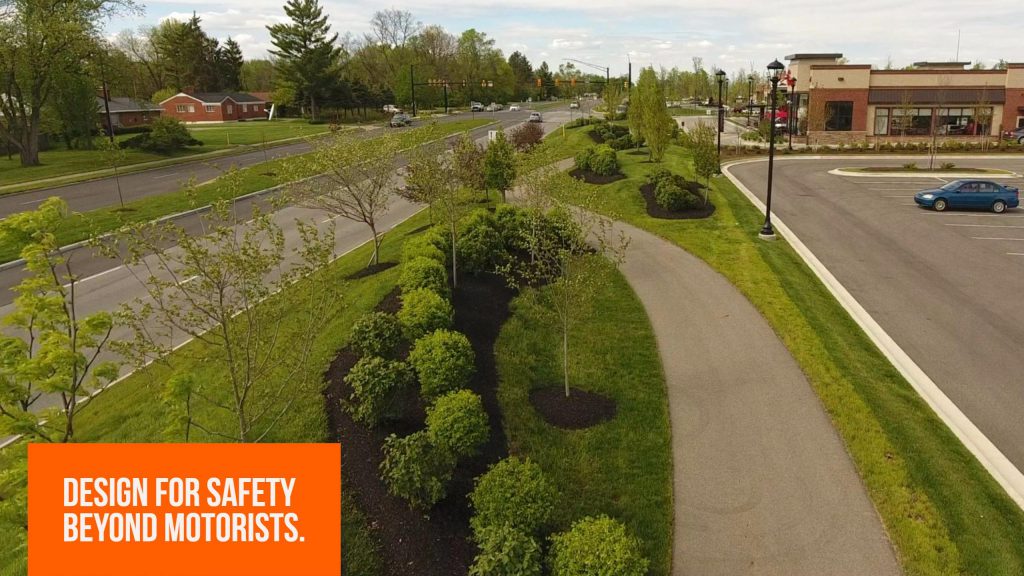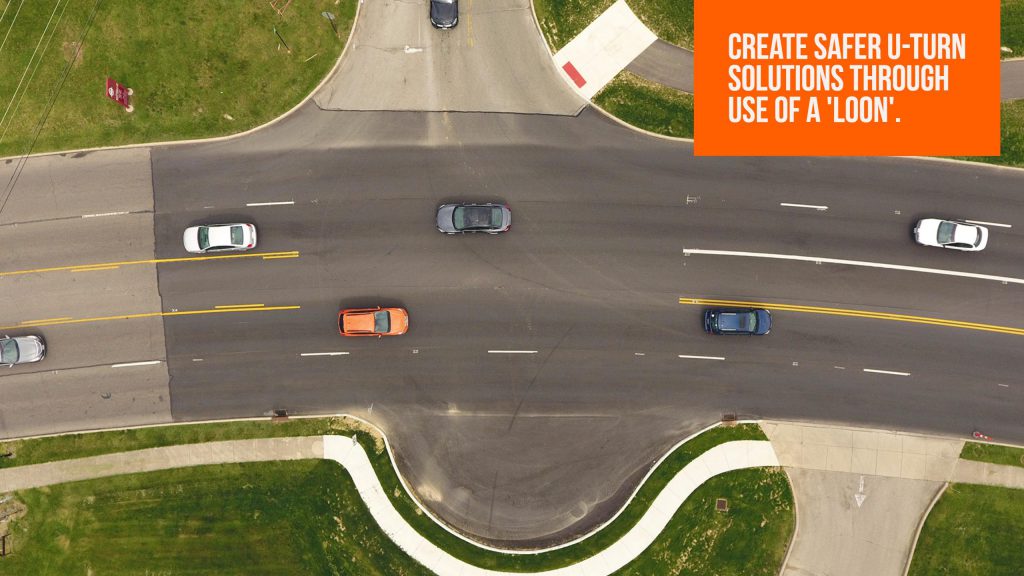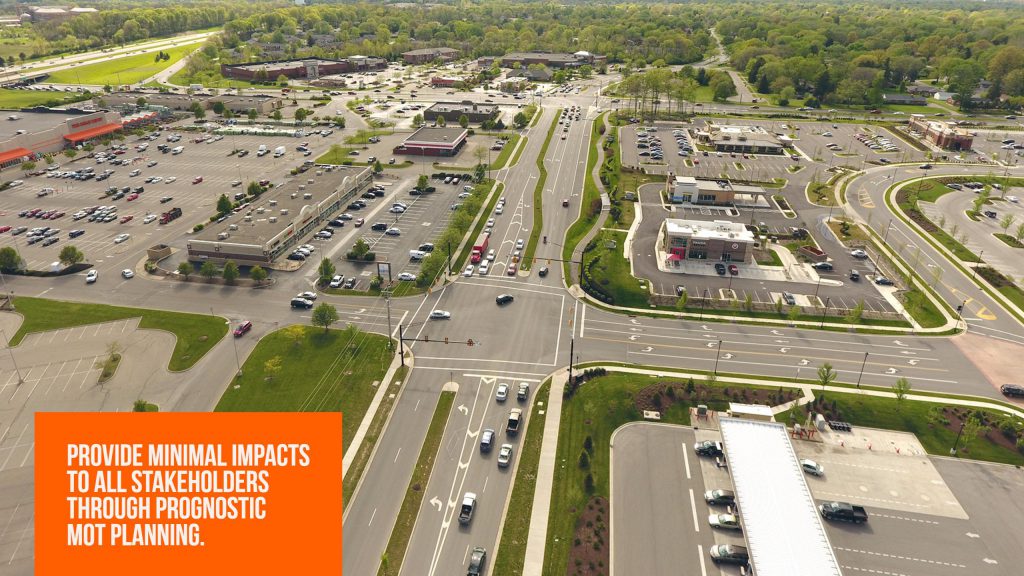Considerations When Planning Next Large-Scale Complete Streets Project
Case Study: Wilmington Pike and Feedwire Road Roadway and Intersection Improvements
Construction was recently completed on the multi-phase project which took a major intersection within Montgomery County from 3-lanes to 9-lanes at the largest point. Already a highly traveled area in the county, a new adjacent development was driving the need for improvements at a large scale. The project area is populated with many retail establishments, restaurants, and homes. All of these stakeholders would be impacted by the development that included Costco, Kroger Marketplace, Cabella’s, and additional outparcels with smaller retail and restaurant space.
The Kleingers Group worked closely with the City of Centerville, homeowners, business owners, and other stakeholders to ensure the design would meet increased traffic capacity needs, accommodate pedestrians, and help keep area businesses operational.
Below are examples of things to consider when planning your next large-scale complete-streets, roadway design project.
Minimizing the Impacts on Businesses Through Design
Maintenance of traffic (MOT) in any roadway project can make or break the businesses affected during construction. Kleingers found challenges throughout the three phases of the project but worked to address or even predict each one.
Number one, the entire project scope (all 3 phases) was designed early in the process to ensure that each end of the project would have the least impact on the right-of-way, and ultimately the existing businesses along with the design. Creating this initial master plan allowed our engineers to create a design that provided no disruption to the area businesses. For some businesses, losing parking spaces could mean closing their doors. Because of Kleingers’ universal look early in the design process, no parking stalls were affected during construction or lost after completion of the project. Kleingers’ worked with the city to help predict future phases and affected areas to ultimately help save money.
Speaking of saving money, and resources, Kleingers’ carefully coordinated plans to help save on temporary paving costs by salvaging pavement from other phases of the project. The salvaged pavement was used to reduce construction costs where temporary pavement was needed for maintaining 2-lanes of traffic.
Not only was the area already highly populated, but the thoroughfare was an important route for nearby hospitals and other emergency crews. Kleingers coordinated with local hospitals, the city, and its emergency services departments to ensure 2-lanes would remain operational during the life of construction so that emergency crews could operate, business as usual.
 More than Just Roadway Improvements – Complete Streets
More than Just Roadway Improvements – Complete Streets
Complete streets are defined as ‘streets for everyone’ and ‘a means to make it easy to cross the street, walk to shops, and bicycle to work.’ The Wilmington Pike and Feedwire Road project was designed to address safety for all travelers beyond motorists, including pedestrians, bicyclists, and transit riders.
With traditional sidewalks provided on one side, 8-foot wide meandering paved trails, and a concrete bus stop for Dayton RTA riders, the project was challenged with not only creating the means for safety but also creative drainage solutions.
Our traffic engineers took into account ADA and pedestrian safety when designing for three traffic signals along with the project. The design provided key elements such as voice-activated pedestrian push buttons that are timed and integrated with the signal system; ADA curb ramps; and landscape mounds along with the development which obstructs headlights that beam into on-coming traffic. The project also incorporates a pull-off bus stop for Dayton RTA riders along with ADA access and a gazebo that protects transit riders. All of these elements working together provide safe access for pedestrians and bicyclists in the area.
The city looked to Kleingers to help find the balance of economics when comparing adding more right-of-way (ROW) costs or providing environmental and water quality structures to address drainage design. Typically, on most projects where adding more ROW to a project has little impact on local businesses or homeowners, the simple solution is to create larger ditches to handle drainage runoff. In this particular project where the project was constrained by several existing businesses, the cost-effective solution to drainage was to add water quality structures. In doing so, the designers were able to also address environmental concerns while maintaining precious ROW.
 The Loon – Designing Safe ‘Out-Of-The-Box’ Solutions for U-Turns
The Loon – Designing Safe ‘Out-Of-The-Box’ Solutions for U-Turns
Roadway engineers are continually looking for ways to improve vehicular and pedestrian safety. A rare, ‘out-of-the-box solution for drivers who want to safely cross or make a U-turn on a divided roadway is through the use of a ‘Loon through-turn’ design. So, what is a loon? The loon is pavement that is constructed outside of the normal traffic lane within the right-of-way space. This additional area allows vehicles, especially larger ones, to safely make a U-turn on a roadway divided by a median.
Where lanes were widened to accommodate the increase in traffic, a median was created to provide safer access for those who live along this stretch of road. The installation of the loon helps those who have headed northbound access their homes on the other side of the new median without the safety implications of crossing large amounts of oncoming traffic.
 Predicting Construction Conflicts in A 3-Phase Project
Predicting Construction Conflicts in A 3-Phase Project
Often, unforeseen construction issues are a leading contributor to increased construction costs during a project. Kleingers considered all aspects of construction coordination between project phases when designing the roadway improvements, such as drainage, utility coordination, elevation changes with a neighboring development project, and much more.
The Kleingers’ team was able to provide contractors with finished elevations for coordination of major utilities, including water mains, gas mains, and power distribution lines. By telling contractors exactly where to locate lines, even in areas that had not been graded for elevations, those utility contractors could be on-site once during the life of the project without additionally impacting the schedule later in construction. It also meant that site contractors would have to grade the site less and fewer materials would be required, ultimately saving time and money.
By working alongside the designers for the adjacent site development project, The Kleingers Group could provide regular updates on a continuous basis. Adjusting for site elevation, drainage, and utility changes during the project’s design phase. This allowed Kleingers to maintain continuous control of the project while in the field. This extra coordination helped Kleingers quickly accommodate for construction surprises in the field, helping to alleviate downtime on the project.
In summary, a successful large-scale complete street project will require close coordination among all stakeholders during the design phases to mitigate common budget and schedule busting events.
4 Ways the Kleingers Group Will Make Your Next Traffic Count Better
The Kleingers Group recently acquired unmanned bird’s eye perspective video capture devices, a new way to conduct traffic counts. Rather than requiring a person to stand at an intersection, the new technology converts images to data using video collected through a battery-operated camera.
The benefits to you are:
- Access to Multiple Days of Data at No Extra Cost: A traditional intersection traffic count only collects one day of data. Sometimes something unexpected happens, such as a crash on a nearby street that diverts traffic and creates a high count. With video capture devices, The Kleingers Group has access to several days of data to ensure the traffic count is giving a representative picture.
- Counts at Abnormal Locations (such as Roundabouts) at A Reduced Cost: Busy roundabouts are notoriously hard to count because the person counting has to follow the car along its entire path through the roundabout. Often roundabouts require multiple people to conduct a count, raising costs. With video capture, costs don’t increase.
- More Information than Just Numbers: Sometimes traffic patterns need to be observed to get the full picture. An intersection may be too busy for a person to count the traffic and simultaneously make notes of needed observations. Now, video can be reviewed directly, allowing the engineer to make the necessary observations, often at a sped-up rate. The end result is more information to help you make smart decisions.
- The Ability to Review Data at A Later Time: Sometimes specific questions about existing conditions don’t arise until after the traffic count is finished. With video capture, The Kleingers Group can go back and review the video on file to answer new questions, saving a repeat field visit.
Read how The Kleingers Group is using new technology to create an innovative parking solution on Blue Ash Road or contact The Kleingers Group to discuss how we can use video capture and smart analysis to help solve your traffic or parking problem.
What’s the Back-Up Plan? Changing the Parking Scheme on Blue Ash Road
Backing out of 90-degree on-street parking into a busy road is generally recognized as a very dangerous parking maneuver. Drivers often can’t get a good view of oncoming traffic before pulling into it, leading to driver anxiety and accidents.
So when The Kleingers Group started a safety improvement study for Blue Ash Road in the City of Deer Park, the existing 90-degree on-street parking was a major concern.
The transportation and infrastructure group used Miovision Scout Data Collectors—a camera that records video for use in data collection and observation—to observe parking maneuvers along the corridor. With video capture, they were able to cost-effectively perform over a day’s worth of observations at a birds-eye view.
What they found was surprising: a good portion of drivers were already backing into the existing 90-degree parking spaces to enable themselves to be able to see when they pulled out later.
This knowledge led The Kleingers Group to consider reverse angle parking, an innovative solution.
Unlike traditional angled parking, in which drivers pull into a space head-on, reverse angle parking encourages drivers to drive just past an open space and back in, vastly improving visibility when they pull out. The result is parking that is safer for both drivers, cyclists, and pedestrians.
Although reverse-angle parking is less common than traditional angled parking, the data from video observation showed that a culture of backing into on-street parking already existed.
“We learned that a good portion of drivers were already making maneuvers similar to the changes we were proposing,” Traffic Engineer Dave Meyer said. “Reverse angle parking will allow much greater visibility when you are exiting a parking spot.”
Although education campaigns will still be necessary to acquaint residents with the alternative parking scheme, many drivers won’t have to substantially change their habits. By encouraging the remaining drivers to also back into their parking space, accidents should be reduced and parking will be safer for motorists, cyclists, and pedestrians.
The result is increased economic development—including visitors, shoppers, and diners—as people feel safer parking and, as a result, frequenting the area.
Improvements to Blue Ash Road are expected to be completed in 2019.